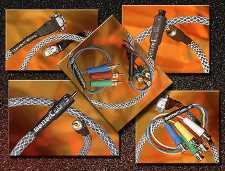 |


TechnoFILE is copyright and a registered trademark © ® of
Pandemonium Productions.
All rights reserved.
E-mail us Here!

Using ConnectionsBy Jim BrayIt pays to have connections when you've invested in a home theater. I don't mean it's good to know people, though that never hurts. I mean it can pay to spend a little extra on the cables that connect your electronic components together. In this space I've talked about various "interconnects" before, reviewing a couple of different types, but I've never really gone into the "WHY?" of upgrading your cables. Hence this column. "Interconnects" are your speaker wire and connecting cables. If you buy mainstream electronics, your components probably come with interconnects, but I can tell you unequivocally that most interconnects that are included in the box are junk. They have cheap wire and lousy ends, proving that you get what you pay for, at least to a point. Upgrading your interconnects isn't for everyone, however. Many people, who don't live and breathe this stuff, are perfectly happy with generic cables, and probably couldn't hear the difference anyway. But people who want the best bang they can get, regardless of the bucks, can benefit from upgraded interconnects. I'm not going to get into brands or technology; instead, I'll just offer some tips you can use if you want to upgrade your connections without breaking your budget. There are three main areas of improvement that should be apparent to all but the tinniest of ears, though it may require sitting down and auditioning the equipment in the privacy of your own listening/viewing room. The first is the dynamics, the volume between the quietest and the loudest passage of a piece of music. You should notice an improvement here, meaning you won't have to ride the volume control as much, if at all. The second noticeable improvement is the imaging of the soundstage, which helps make your speakers virtually disappear into a roomful of glorious sound (depending on the rest of your system). The third improvement will be in vocals (whether singing or dialog), which become more clear, rich and lifelike. These enhancements will improve the overall sound, even to making explosions and spaceships sound better as they zip around the home theater. Good interconnects are generally (though not always) thicker than the junky stuff. Just as water passes more quickly through a wider hose, electrons can flow better through a thicker interconnect, assuming all else is equal. Improving the electron flow is why, depending on the company, manufacturers resort to things like wrapping thinner gauge wires around thicker gauge wires, and using different materials and/or techniques to ensure the different frequencies go straight to the proper speaker driver without passing "Go" or collecting $200. Perhaps equally important to the quality of the wire itself is the quality of the ends, the doodads that connect the wires to the actual components. They should connect firmly and make a good electrical contact without grabbing so tightly that they won't come loose again without major bouts of profanity. Remember, too, when buying speaker cables that you should ensure their ends will fit the amplifier and the speaker terminals. Five-way binding posts on your speakers and amp are the best, and are getting more popular all the time, but they aren't ubiquitous. I like to have "banana plugs" (which look like a little metal banana and slide easily into the terminal) at the ends of my speaker wire. They work really well with 5-way binding posts, but sticking one into those little squeezy-type terminals that are common on lower end equipment is a chore and could damage your equipment. There's no "correct" connector. Just make sure all yours are compatible. Then there's the question of which cables to upgrade first. If you like music, start with better audio cables. If you're into DVD and have just dropped a good sized wad on a player and TV, a good set of component video cables and a good optical or coaxial digital audio cable would be an excellent place to start. How much should you pay? A good rule of thumb is ten per cent: if you're spending $1000 on the system, then $100 is a fair amount for interconnects. That may seem like a lot, but wait until you see how much you COULD spend! Remember, upgrading your cables isn't for everyone, but if your audio and video is really important to you, they offer a chance to maximize your investment and enjoyment. Jim Bray's technology articles are distributed by the TechnoFILE Syndicate. Copyright Jim Bray.
|
|
|
| Support TechnoFile via Paypal |
| TechnoFILE's
E-letter We're pleased to offer our FREE private, subscription-based private E-mail service. It's the "no brainer" way to keep informed. Our Privacy Policy |